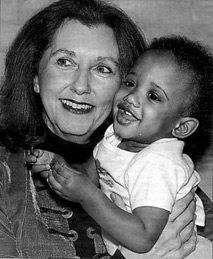
Roots of Empathy: Changing the World Child by Child
Mary Gordon Thomas Allen
Reviewed by Keith Oatley, The Globe & Mail, Books, January 28, 2006
0f all our human characteristics, empathy is among the most important. Adam Smith thought that the set of emotional traits that includes empathy, sympathy and compassion was the glue that holds society together. He called these traits "moral sentiments." A bit more than 200 years after his famous book on the subject was published, his proposals that these traits form the emotional bases for right action in society have been largely substantiated by research in child development.
In The Roots of Empathy, Mary Gordon, who was born and raised in Newfoundland, draws on this research and describes a program to foster empathy that she started in Toronto nearly 10 years ago. It involves having mothers bring their babies into classrooms for an hour a month for nine months of the school year, with a trained instructor present. A week before the visit, the instructor prepares the class, and a week after it, the instructor leads an hour's discussion on the visit. The program is specialized for three age groups, Grades 1 to 3,4 to 6 and 7 to 8. It now runs in eight Canadian provinces and has been taken by 68,000 children.

Gordon: one of the first to teach 'emotional intelligence.'
Nowadays, we hear a good deal about emotional intelligence. Mary Gordon's brilliant idea is one of the first to show how it might be learned. In her impressive book, Gordon describes the program and its effects on the children's engagement with the babies during their visits, their appreciation of the babies' feelings and their concerns for the babies' developmental accomplishments.
Among her examples is a boy she calls Darren, who had a very troubled home life. He lost his mother at the age of 4 and lived subsequently in a succession of foster homes. In Grade 8, he had already been held back for two years, and he dressed to look menacing. At the end of the visit of a baby to Darren's classroom, the mother of the baby asked if anyone wanted to try on the Snugli, the pouch in which a baby can be carried on a parent's chest. Then, Gordon writes, "To everyone's surprise, Darren offered to try it." He asked if the baby could be put in. Although the mother was a bit apprehensive, the baby was put in, and snuggled up to him. Darren walked to a corner and rocked the baby for several minutes, after which he came back to the mother and the Roots of Empathy instructor and asked: "If nobody has ever loved you, do you think you could still be a good father?" Gordon wonders whether perhaps for this boy a seed was sown.
The book's third section is on the relation of the program to society, with themes of bullying, infant safety, teaching and parenting. Most striking in this third section is the chapter on bullying. Empathy and bullying are opposites. Whereas empathy is identifying with another person, bullying is inflating oneself by attacking the other. The bully is always the more powerful, and the victim is usually seen as being different from others in some way. Throughout history, bullying has been the hallmark of repressive regimes and the rallying call of nations seeking to impose their will on others.
Gordon's describes how, when the small and powerless baby visits the classroom, overwhelmingly it is empathy that is elicited. Many of her anecdotes are of children in the program who, when they see an episode of bullying begin in the corridor or schoolyard, empathically take the side of the potential victim rather than joining the bully or passively looking on.
With any new program, the question is: "Does it work?" In an appendix of this book is a study by Kimberly Schonert Reichl. of the University of British Columbia. She found that samples of children who took the Roots of Empathy program showed decreased tendencies to bully others, as well as increased emotional understanding and cooperation, as compared with children in samples who did not take the program.
Keith Oatley is director of the Cognitive Science Program at the University of Toronto.
The Citizen's Handbook / Home / Table of Contents
The Citizen's Handbook / Charles Dobson / citizenshandbook.org

The Troublemaker's Teaparty is a print version of The Citizen's Handbook published in 2003. It contains all of The Handbook plus additional material on preventing grassroots rot, strategic action, direct action and media advocacy. You can get a copy of The Teaparty from bookstores, Amazon or New Society Publishers.